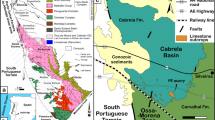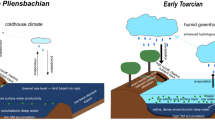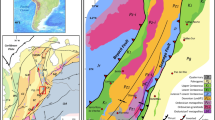Abstract
This paper examines a 115 cm long profile section of lacustrine-swamp sediments from the Langou I Bay (eastern part of Primorsky Krai; 44°25′10.16″ N, 135°54′26.08″ E). According to the produced age model, the sediments are 3900 years old. A multiproxy study involving geochemical, chironomid, diatom, and palynological analysis indicates that the climatic and environmental conditions on the seacoast in the eastern part of Primorsky Krai developed in many respects synchronously with known climatic phases of the Late Holocene. The period from ca. 4200 to 2600 cal years BP corresponds to the first and second warm stages of the Jōmon period and the late Jōmon transgression in Japan. The peak of summer temperatures in the vicinity of the Langou I Bay occurred between 2900 and 2600 cal years BP. The cooling that began after 2600 cal years BP was not as severe in the study area as in Japan (cold Jōmon and Kofun stages): the reconstructed temperatures were 1°C lower than now; in Japan, they were 2–3°C below the current level. The Medieval Climate Optimum (Nara–Heian–Kamakura stage in Japan) reconstructed for the eastern part of Primorsky Krai in the period from 1250 to 750 cal years BP featured a humid climate with summer temperatures ca. 1.5°C higher than at present. The period between 750 and 250 cal years BP correlates with the Little Ice Age: summer temperatures had dropped to 1.5–2°C below the modern one. In the last 200 years, the lake has been shallowing and has nearly dried out. This period is marked by temperature fluctuations amid the trend of climate warming.







Similar content being viewed by others
REFERENCES
Atlas lesov Primorskogo kraya (Atlas of Forests of Prymorsky Krai), Vladivostok: Dal’nevost. Otd. Ross. Akad. Nauk, 2005.
Barinova, S.S., Medvedeva, L.A., and Anissimova, O.V., Diversity of Algal Indicators in Environmental Assessment, Tel Aviv: Pilies Studio, 2006.
Battarbee, R.W., Diatom analysis, in Handbook of Holocene Paleoecology and Paleohydrology, London: Wiley & Sons, 1986, pp. 527–570.
Bazarova, V.B., Grebennikova, T.A., and Orlova, L.A., Natural-environment dynamics within the Amur Basin during the neoglacial, Geogr. Nat. Res., 2014, vol. 35, no. 3, pp. 275–283.
Blaauw, M. and Christen, J.A., Flexible paleoclimate age-depth models using an autoregressive gamma process, Bayesian Anal., 2011, vol. 6, pp. 457–474.
Brooks, S.J., Langdon, P.G., and Heiri, O., The Identification and Use of Palaearctic Chironomidae Larvae in Palaeoecology, London: Quat. Res. Assoc., 2007.
Brooks, S.J., Diekmann, B., Jones, V.J., and Hammarlund, D., Holocene environmental change in Kamchatka: A synopsis, Global Planet. Change, 2015, vol. 134, pp. 166–174.
Demezhko, D.Y. and Solomina, O.N., Ground surface temperature variations on Kunashir island in the last 400 years inferred from borehole temperature data and tree-ring records, Dokl. Earth Sci., 2009, vol. 426, no. 1, pp. 628–631.
Diatomovye vodorosli SSSR: (Iskopaemye i sovremennye) (Fossil and Modern Diatom Algae of the USSR), Leningrad: Nauka, 1974, vol. 1.
Druzhinina, O., Kublitskii, J., Nazarova, L., Subetto, D., Syrykh, L., Arslanov, Kh., Stančikaitė, M., Vaikutiene, G., and Kul`kova, M., Palaeoenvironmental conditions in South-Eastern part of the Baltic region during the Late Pleistocene–Holocene transition (Kaliningrad District, Russia), Boreas, 2020, vol. 49, no. 3, pp. 544–561.
Frolova, L.A., Nazarova, L.B., Pestryakova, L.A., and Herzschuh, U., Analysis of the effects of climate-dependent factors on the formation of zooplankton communities that inhabit arctic lakes in the Anabar River Basin, Contemp. Probl. Ecol., 2013, vol. 6, no. 1, pp. 1–11.
Ganzey, L.A., Razjigaeva, N.G., Nishimura, Yu., Grebennikova, T.A., Kaistrenko, V.M., Gorbunov, A.O., Arslanov, Kh.A., Chernov, S.B., and Naumov, Yu.A., Deposits of historical and paleotsunamis on the coast of Eastern Primorye, Russ. J. Pac. Geol., 2015, vol. 9, no. 1, pp. 64–79.
Heusser, C.J. and Igarashi, Y., Quaternary migration pattern of Selaginella selaginoides in the North Pacific, Arct. Alp. Res., 1994, vol. 26, no. 2, pp. 187–192.
Hill, M.O., Diversity and evenness: A unifying notation and its consequence, Ecology, 1973, vol. 54, pp. 427–432.
Hoff, U., Biskaborn, B.K., Dirksen, V., Dirksen, O., Kuhn, G., Meyer, H., Nazarova, L., Roth, A., and Diekmann, B., Holocene environment of Central Kamchatka, Russia: Implications from a multi-proxy record of Two-Yurts Lake, Global Planet. Change, 2015, vol. 134, pp. 101–117.
Juggins, S., Software for Ecological and Palaeoecological Data Analysis and Visualization. C2 Version 1.5 User Guide, Newcastle: Newcastle Univ., 2007.
Kaufman, D., McKay, N., Routson, C., Erb, M., Davis, B., Heiri, O., Jaccard, S., Tierney, J., Dätwyler, C., et al., A global database of Holocene paleo-temperature record, Sci. Data, 2020, vol. 7, p. 115.
Kawahata, H., Ohshima, H., Shimada, C., and Oba, T., Terrestrial–oceanic environmental change in the southern Okhotsk Sea during the Holocene, Quat. Int., 2003, vol. 108, pp. 67–76.
Kitagawa, H. and Matsumoto, E., Climatic implications of δ13C variations in a Japanese cedar (Cryptomeria japonica) during the last two millennia, Geophys. Res. Lett., 1995, vol. 22, no. 16, pp. 2155–2158.
Kohfeld, K.E. and Harrison, S.P., How well can we simulate past climates? Evaluating the models using global palaeoenvironmental datasets, Quat. Sci. Rev., 2000, vol. 19, no. 1, pp. 321–346.
Koizumi, I., Spectral analysis of the diatom paleotemperature records at DSDP Sites 579 and 580 near the subarctic front in the western North Pacific, Palaeogeogr. Palaeoclim. Palaeoecol., 1994, vol. 108, pp. 475–485.
Korotkii, A.M., Grebennikova, T.A., Pushkar’, V.S., Razzhigaeva, N.G., Volkov, V.G., Ganzei, L.A., Mokhova, L.M., Bazarova, V.B., and Makarova, T.R., Climatic changes in the South of the Far East in the Late Pleistocene–Holocene, Vestn. Dal’nevost. Otd. Ross. Akad. Nauk, 1997, no. 3, pp. 121–143.
Krammer, K. and Lange-Bertalot, H., Bacillariophyceae, vol. 1: Naviculaceae, Jena: VEB Gustav Fischer Verlag, 1986.
Krammer, K. and Lange-Bertalot, H., Bacillariophyceae, vol. 2: Bacillariaceae, Epithemiaceae, Surirellaceae, Jena: VEB Gustav Fischer Verlag, 1988.
Krammer, K. and Lange-Bertalot, H., Bacillariophyceae, vol. 3: Centrales, Fragilariaceae, Eunotiaceae, Jena: VEB Gustav Fischer Verlag, 1991a.
Krammer, K. and Lange-Bertalot, H., Bacillariophyceae, vol. 4: Achnanthaceae. Kritische Erganzungen zu Navicula (Lineolatae) und Gomphonema, Jena: VEB Gustav Fischer Verlag, 1991b.
Meyer, H., Chapligin, B., Hoff, U., Nazarova, L., and Diekmann, B., Oxygen isotope composition of diatoms as Late Holocene climate proxy at Two-Yurts-Lake, Central Kamchatka, Russia, Global Planet. Change, 2015, vol. 134, pp. 118–128.
Nazarova, L., Pestryakova, L.A., Ushnickaja, L.A., and Hubberten, H.-W., Chironomids (Diptera: Chironomidae) of Central Yakutian lakes and their indicative potential for palaeoclimatic investigations, Contemp. Probl. Ecol., 2008, vol. 1, no. 3, pp. 335–345.
Nazarova, L., Herzschuh, U., Wetterich, S., Kumke, Th., and Pestjakova, L., Chironomid-based inference models for estimating mean July air temperature and water depth from lakes in Yakutia, northeastern Russia, J. Palaeolimnol., 2011, vol. 45, pp. 57–71.
Nazarova, L., de Hoog, V., Hoff, U., and Diekmann, B., Late Holocene climate and environmental changes in Kamchatka inferred from subfossil chironomid record, Quat. Sci. Rev., 2013, vol. 67, pp. 81–92.
Nazarova, L., Self, A., Brooks, S.J., van Hardenbroek, M., Herzschuh, U., and Diekmann, B., Northern Russian chironomid-based modern summer temperature data set and inference models, Global Planet. Change, 2015, vol. 134, pp. 10–25.
Nazarova, L.B., Self, A.E., Brooks, S.J., Solovieva, N., Syrykh, L.S., and Dauvalter, V.A., Chironomid fauna of the lakes from the Pechora river basin (east of European part of Russian Arctic): Ecology and reconstruction of recent ecological changes in the region, Contemp. Probl. Ecol., 2017a, vol. 10, no. 4, pp. 350–362.
Nazarova, L., Bleibtreu, A., Hoff, U., Dirksen, V., and Diekmann, B., Changes in temperature and water depth of a small mountain lake during the past 3000 years in Central Kamchatka reflected by chironomid record, Quat. Int., 2017b, vol. 447, pp. 46–58.
Pokrovskaya, I.M., Methods of paper works, in Paleopalinologiya (Paleopalinology), Leningrad: Nedra, 1966, vol. 1, pp. 32–61.
R Core Team, R: A Language and Environment for Statistical Computing, Vienna: R Foundation for Statistical Computing, 2012.
Razjigaeva, N.G., Ganzey, L.A., Grebennikova, T.A., Belyanina, N.I., Mokhova, L.M., Arslanov, Kh.A., and Chernov, S.B., Holocene climatic changes and vegetation development in the Kuril Islands, Quat. Int., 2013, vol. 290–291, pp. 126–138.
Razjigaeva, N.G., Ganzey, L.A., Grebennikova, T.A., Mokhova, L.M., Kudryavtseva, E.P., Arslanov, Kh.A., Maksimov, F.E., and Starikova, A.A., Landscape and environmental changes of Eastern Primorye coast at middle-late Holocene: Climatic changes and human impact effects, J. Asian Earth Sci., 2018, vol. 158, pp. 160–172.
Razjigaeva, N.G., Ganzey, L.A., Lyaschevskaya, M.S., Makarova, T.R., Kudryavtseva, E.P., Grebennikova, T.A., Panichev, A.M., Arslanov, Kh.A., Maksimov, F.E., Petrov, A.Yu., and Malkov, S.S., Climatic and human impacts on landscape development of the Murav’ev Amursky Peninsula (Russian South Far East) in the Middle/Late Holocene and historical time, Quat. Int., 2019, vol. 516, pp. 127–140.
Razzhigaeva, N.G., Ganzey, L.A., Grebbennikova, T.A., Kopoteva, T.A., Mokhova, L.M., Panichev, A.M., Kudryavtseva, E.P., Arslanov, Kh.A., Maksimov, F.E., Petrov, A.Yu., and Klimin, M.A., Environmental changes recorded in deposits of the Izyubrinye Solontsi Lake, Sikhote-Alin, Contemp. Probl. Ecol., 2017, vol. 10, no. 4, pp. 441–453.
Razzhigaeva, N.G., Ganzey, L.A., Makarova, T.R., Kornyushenko, T.V., Ganzei, K.S., Sudin, V.V., and Kharlamov, A.A., Paleolake of Shkot Island (Peter the Great Gulf): Natural archives of climatic and landscape vegetation, Geosyst. Transition Zones, 2020, vol. 4, no. 2, pp. 230–249.
Rudaya, N., Nazarova, L., Novenko, E., Andreev, A., Kalugin, I., Daryin, A., Babich, V., Li, H.-Ch., and Shilov, P., Mid Holocene climate and vegetation in the Northern Altay mountains recorded in Lake Teletskoe, Global Planet. Change, 2016, vol. 141, pp. 12–24.
Sakaguchi, Y., Warm and cold stages in the past 7600 years in Japan and their global correlation, Bull. Dept. Geogr. Univ. Tokyo, 1983, vol. 15, pp. 1–31.
Smol, J.P., Pollution of Lakes and Rivers: A Paleoenvironmental Perspective, New York: Arnold Publ., 2002.
Solovieva, N., Klimaschewski, A., Self, A.E., Jones, V.J., Andrén, E., Andreev, A.A., Hammarlund, D., Lepskaya, E.V., and Nazarova, L., Holocene environmental history of a small coastal lake from north-eastern Kamchatka Peninsula, Global Planet. Change, 2015, vol. 134, pp. 55–66.
Subetto, D.A., Nazarova, L.B., Pestryakova, L.A., Syrykh, L.S., Andronikov, A.V., Biskaborn, B., Diekmann, B., Kuznetsov, D.D., Sapelko, T.V., and Grekov, I.M., Palaeolimnological studies in Russian Northern Eurasia: A review, Contemp. Probl. Ecol., 2017, no. 4, pp. 327–335.
Syrykh, L.S., Nazarova, L.B., Herzschuh, U., Subetto, D.A., and Grekov, I.M., Reconstruction of palaeoecological and palaeoclimatic conditions of the Holocene in the south of Taimyr according to the analysis of lake sediments, Contemp. Probl. Ecol., 2017, no. 4, pp. 363–369.
Taira, K., Environmental changes in eastern Asia during the past 2000 years. volcanism, tectonism, climate and palaeooceanology, Palaeogeogr. Palaeoclimatol. Palaeoecol., 1980, vol. 32, pp. 89–97.
ter Braak, C.J.F. and Prentice, I.C., A theory of gradient analysis, Adv. Ecol. Res., 1988, vol. 18, pp. 271–317.
Wiederholm, T., Chironomidae of the Holarctic Region, Part 1: Larvae, Lund: Entomological Society of Lund, 1983, suppl. 19.
Yasuda, Y., Climatic changes and the development of Jomon Culture in Japan, in Nature and Humankind in the Age of Environmental Crisis, Proc. of the VI Int. Symp. at the Int. Res. Centre for Japanese Studies, 1995, pp. 57–77.
Zhilich, S., Rudaya, N., Krivonogov, S., Nazarova, L., and Pozdnyakov, D., Environmental dynamics of the Baraba forest-steppe over the last 8000 years and their impact on the types of economic life of the population, Quat. Sci. Rev., 2017, vol. 163, pp. 152–161.
ACKNOWLEDGMENTS
We are grateful to participants of expeditions to the study area and to N.P. Domra of the Federal Scientific Center of the East Asia Terrestrial Biodiversity, Far East Branch, Russian Academy of Sciences, for preparing specimens for the spore–pollen analysis.
Funding
This study was supported by the German Research Foundation (Deutscheforschungsgemeinschaft, DFG), project no. NA 760/5-1, and performed as part of the state assignment of the Pacific Geographical Institute, Far East Branch, Russian Academy of Sciences, theme no. AAAA-A19-119030790003-1. The production of the databases used in this study was supported by the Russian Science Foundation, project no. 20-17-00135.
Author information
Authors and Affiliations
Corresponding author
Ethics declarations
The authors declare that they have no conflicts of interest. This article does not contain any studies involving animals or human participants performed by any of the authors.
Additional information
Translated by L. Emeliyanov
Rights and permissions
About this article
Cite this article
Nazarova, L.B., Razjigaeva, N.G., Golovatyuk, L.V. et al. Reconstruction of Environmental Conditions in the Eastern Part of Primorsky Krai (Russian Far East) in the Late Holocene. Contemp. Probl. Ecol. 14, 218–230 (2021). https://doi.org/10.1134/S1995425521030094
Received:
Revised:
Accepted:
Published:
Issue Date:
DOI: https://doi.org/10.1134/S1995425521030094




